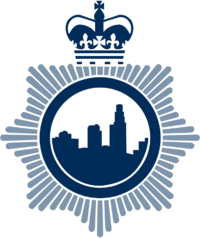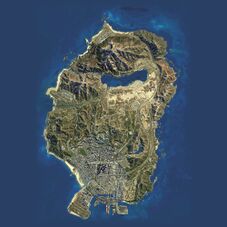GTA:Los Santos Police Service
| Abbreviation | LSPS | |
| Agency Overview | ||
|---|---|---|
| Formed | 22nd Febuary 2020 | |
| Employees | 280 Approximately | |
| Legal Personality | Police Force | |
| Jurisdiction | ||
| Operations Jurisdiction | San Andreas | |
| Size | 127km2 (49 sq mi) | |
| Population | Around 29 Million | |
| Structure | ||
| Overviewed by |
|
|
| Headquarters |
| |
| Agency Executives |
|
|
| Facilities | ||
| ||
| Website | ||
The Los Santos Police Service (LSPS) is the territorial police force responsible for law enforcement across San Andreas, covering an area of 127 km2.
Operational Structure
The Los Santos Police Service is organised into the following directorates:
Each directorate is made up of 25 officers, with the exception of Specialist Operations which has 15. Each directorate has 4 operational teams consisting of Sergreants and Police Constables.
Police Command
The Silver Command is made up of 3 officers. 1 Chief Superintendent (C/Supt) and 2 Superintendents (Supt). The Bronze Command is made up of 1 Chief Inspector (C/Insp) and 2 Inspectors (Insp) for each directorate with the exception of Specialist Operations which only has 1 Inspector. Within Frontline and Traffic there are 4 teams each led by a Sergeant each with 8 Constables. In Specialist Operations there are only 2 teams.
| Chief Superintendent | |
|---|---|
| Shane Jones | |
| Superintendents | |
| Shepherd Kingston | Barry Greenhalgh |
Frontline Policing
Frontline policing officers perform standard patrols around the Los Santos area whilst responding to incidents and 999 calls. They ustilise Incident Response Vehicles and Area Cars. Each vehilce performing frontline policing duties is assigned the Yankee-Victor callsign.
Traffic Policing
Traffic Policing officers are specially trained in enforcing road traffic laws and high speed pursuits. They are also trained in tactical pursuit tactics such as TPACs and Hard Stops in order to prevent offenders who attempt to escape via the roads. They utilise Traffic Pursuit Vehicles. Each vehilce performing traffic policing duties is assigned the Romeo-Papa callsign.
Specialist Operations
Specialist operations is a cluster of multiple units. Starting with the firearms unit: Officers in this directorate consist of Authorised Firearms Officers (AFO) and Specialist Firearms Officers (SFO). They utilise Armed Response Vehicles (ARV) in Tactical Support Teams (TST) to respond to firearms and violent crime incidents, as well as working as trojan proactive units as visible armed response vehicle patrols in areas of high crime to deter those who pose a threat. Each vehilce performing specialist operations duties is assigned the Trojan callsign.
Besides that is the National Police Air service, officers in this directorate consists of pilots who pass flight training and tests. They specialise in air surveilance, persuits and searching suspects. The members in specialist operations are the inspector and sergeant of NPAS, who is leading the unit, everyone who is part of the unit as a pilot, are regular officers in frontline, traffic or firearms.
The Dog Support unit has a same structure as NPAS and MPO, where 1 inspector and 1 sergeant is leading within specialist operations, and the members are part of frontline, traffic or firearms. Dog handlers are highly trained to use dogs for searching, defending themselves and normal patrol duties. They utilise the Mercedis Benz vito and Skoda Suburb.
The Marine Policing Operations is specialised in water operations, and lead by 1 inspector and 1 sergeant. They are trained in diving, and driving boats in persuits. They only have 1 boat in their arsenal for now, and the department is still under construction.
Ranks
The Los Santos Police Service uses the standard British Police ranks, indicated by shoulder boards (epaulettes), up to Chief Superintendent.
Junior Ranks and Trainees:
- Probationary Police Constable (P/Constable): "PC" written on the epaulette with "Police Constable", name and collar number also displayed.
- Police Constable (Constable): "PC" Written on the epaulette with "Police Constable", name and collar number also displayed. Note that any officer above Police Constable has passed all their initial training as provided by the Police Academy and therefore at this point officers become entirely responsible for their own decision making in relation to the National Decision Model (NDM)
Bronze Command:
- Sergeant (Sgt): Three pointing-down chevrons above the divisional call sign and shoulder number, officers above this rank may have additional powers to authorise specific actions.
- Inspector (Insp): Two Order of the Bath stars, informally known as "pips".
- Chief Inspector (C/Insp): Three pips.
Silver Command:
- Superintendent (Supt): Single crown, this is the first Silver Command rank.
- Chief Superintendent (C/Supt): Single crown over one pip.
| Training Ranks | Police Officers | Bronze Command | Silver Command (Police Command) | ||||
|---|---|---|---|---|---|---|---|
| Probationary Police Constable | Police Constable | Sergeant | Inspector | Chief Inspector | Superintendent | Chief Superintendent | |
| Epaulette | |||||||
| Paycheck | £ 140 | £ 160 | £ 180 | £ 210 | £ 240 | £ TBA | £ TBA |
| For a comparison of these ranks with other British police forces see Police Ranks of the United Kingdom | |||||||
Police officers are paid according to a uniform pay scale, which increases with each promotion, starting at £140 for PPCs up to £TBD for C/Supts.
Joining the Police Service
In order to join, aspiring recruits have to fill out the official Police Application Form on the government website and, once received, applications will be reviewed by the Police Command.
Resources
Fleet
The Los Santos Police Service operates and maintains a fleet of various types of vehicles which are used for a range of duties, these include:
- Incident Response Vehicles (IRV) or Response Cars: Used for patrol and 999 emergency response.
- Area Cars: Used for patrolling a particular district, and for 999 emergency response, these vehicles are driven by Bronze and Silver Command.
- Traffic Pursuit Vehicles: Used by Traffic Policing Units to enforce Road Traffic Rules and pursue those who attempt to escape via the roads.
- Armed Response Vehicles (ARV): Used by Armed Response to transport their Authorised Firearms Officers, SFOs and CTSFOs to incidents.
Vehicles
Incident Response Vehicles (IRV) or Response Cars - (used by Frontline Policing):
- Ford Focus (Police Roadcruiser)
- Skoda Octavia VRS
- BMW R 1200RT (Police Bike)
- Vauxhall Insignia Estate (White)
- Ford Mondeo Saloon 2017 (Unmarked)
Traffic Pursuit Vehicles - (used by Traffic Policing):
- Vauxhall Insignia Estate (Black)
- Audi A4 TFSI 35
- Volvo V90
- BMW 530d Touring
- BMW R 1200RT (Police Bike)
- BMW M5 (interceptor)
- BMW 530d F11 2014 (Unmarked)
Armed Response Vehicles (ARV) - (used by Specialist Operations - Firearms):
- Volvo XC90
- BMW 330D Saloon
- BMW X5 40d XDrive
- Police Rancher (Unmarked)
- Fort Ranger 6S (Unmarked)
- BMW X5 (Unmarked)
- BMW 540i
Other
- Mercedes-Benz Sprinter (Riot Van)
- Mercedes-Benz Vito (Dog Van)
- Skoda Suburb (Dog car)
- NPAS EC145 (NPAS helicopter)
- VolksWagen Amarok
- Ford Ranger (Marine Policing Operations)
History
The Los Santos Police Service was formed on the 22nd February 2020, as a method of Policing Los Santos.

